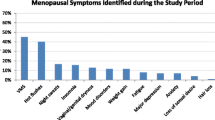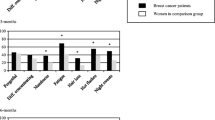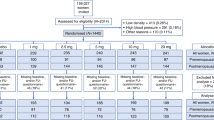Abstract
Purpose
To clarify the profile of adverse events from endocrine therapies in older patients.
Methods
We surveyed 15 subjective symptoms including hot flashes, sweating, knuckle stiffness, knee/shoulder joint pain, limb numbness, lethargy, forgetfulness, depressive state, irritated state, genital bleeding, leukorrhea increase, vaginal dryness, bone fracture, and weight gain by a questionnaire among 2044 patients over 55 years old (total number of answered sheets, 8875) and compared the results according to age (56–69 years old vs. ≥ 70 years old) and type of therapy (aromatase inhibitors (AIs) vs. selective estrogen receptor modulators (SERMs)). Among patients 56–69 years old, 6093 and 314 responses were from patients treated with AIs (1477 patients) and SERMs (123 patients), respectively, and 2292 and 176 responses were from those ≥ 70 years old treated with AIs (581 patients) and SERMs (51 patients), respectively.
Results
In patients ≥ 70 years old, sweating, knuckle stiffness, knee/shoulder joint pain, limb numbness, and lethargy were significantly more frequent/severe with AIs than with SERMs. In those aged 56–69, knuckle stiffness and vaginal dryness were significantly more frequent with AIs than with SERMs, but the opposite occurred for hot flashes, leukorrhea increase, genital bleeding, and weight gain.
Conclusions
Among patients ≥ 70 years old, many symptoms were significantly more frequent/severe with AIs than with SERMs, compared with those aged 56–69, which suggests a difference in the profile of adverse events according to the type of endocrine therapy and the patient’s age. It is important to consider the benefits and risks of each treatment to optimize endocrine therapy for older patients.




Similar content being viewed by others
References
Miller WR, Hawkins RA, Forrest AP (1982) Significance of aromatase activity in human breast cancer. Cancer Res 42:3365s–3368s
Early Breast Cancer Trialists’ Collaborative Group (EBCTCG), Dowsett M, Forbes JF, Bradley R, Ingle J, Aihara T, Bliss J, Boccardo F, Coates A, Coombes RC, Cuzick J, Dubsky P, Gnant M, Kaufmann M, Kilburn L, Perrone F, Rea D, Thurlimann B, van de Velde C, Pan H, Peto R, Davies C, Gray R (2015) Aromatase inhibitors versus tamoxifen in early breast cancer: patient-level meta-analysis of the randomised trials. Lancet 386:1341–1352
Honma N, Hosoi T, Arai T, Takubo K (2015) Estrogen and cancers of the colorectum, breast, and lung in postmenopausal women. Pathol Int 65:451–459
Kennelly R, Kavanagh DO, Hogan AM, Winter DC (2008) Oestrogen and the colon: potential mechanisms for cancer prevention. Lancet Oncol 9:385–391
Lindsay R, Hart DM, Aitken JM, MacDonald EB, Anderson JB, Clarke AC (1976) Long-term prevention of postmenopausal osteoporosis by oestrogen. Evidence for an increased bone mass after delayed onset of oestrogen treatment. Lancet 1:1038–1041
Skafar DF, Xu R, Morales J, Ram J, Sowers JR (1997) Clinical review 91: female sex hormones and cardiovascular disease in women. J Clin Endocrinol Metab 82:3913–3918
Tang MX, Jacobs D, Stern Y, Marder K, Schofield P, Gurland B, Andrews H, Mayeux R (1996) Effect of oestrogen during menopause on risk and age at onset of Alzheimer’s disease. Lancet 348:429–432
Honma N, Saji S, Mikami T, Yoshimura N, Mori S, Saito Y, Murayama S, Harada N (2017) Estrogen-related factors in the frontal lobe of Alzheimer’s disease patients and importance of body mass index. Sci Rep 7:726-017-00815-3
Bernhard J, Luo W, Ribi K, Colleoni M, Burstein HJ, Tondini C, Pinotti G, Spazzapan S, Ruhstaller T, Puglisi F, Pavesi L, Parmar V, Regan MM, Pagani O, Fleming GF, Francis PA, Price KN, Coates AS, Gelber RD, Goldhirsch A, Walley BA (2015) Patient-reported outcomes with adjuvant exemestane versus tamoxifen in premenopausal women with early breast cancer undergoing ovarian suppression (TEXT and SOFT): a combined analysis of two phase 3 randomised trials. Lancet Oncol 16:848–858
Day R, Ganz PA, Costantino JP, Cronin WM, Wickerham DL, Fisher B (1999) Health-related quality of life and tamoxifen in breast cancer prevention: a report from the National Surgical Adjuvant Breast and Bowel Project P-1 Study. J Clin Oncol 17:2659–2669
Day R, Ganz PA, Costantino JP (2001) Tamoxifen and depression: more evidence from the National Surgical Adjuvant Breast and Bowel Project’s Breast Cancer Prevention (P-1) Randomized Study. J Natl Cancer Inst 93:1615–1623
Fallowfield L, Cella D, Cuzick J, Francis S, Locker G, Howell A (2004) Quality of life of postmenopausal women in the Arimidex, Tamoxifen, Alone or in Combination (ATAC) Adjuvant Breast Cancer Trial. J Clin Oncol 22:4261–4271
Fallowfield LJ, Bliss JM, Porter LS, Price MH, Snowdon CF, Jones SE, Coombes RC, Hall E (2006) Quality of life in the intergroup exemestane study: a randomized trial of exemestane versus continued tamoxifen after 2 to 3 years of tamoxifen in postmenopausal women with primary breast cancer. J Clin Oncol 24:910–917
Garreau JR, Delamelena T, Walts D, Karamlou K, Johnson N (2006) Side effects of aromatase inhibitors versus tamoxifen: the patients’ perspective. Am J Surg 192:496–498
Maunsell E, Goss PE, Chlebowski RT, Ingle JN, Ales-Martinez JE, Sarto GE, Fabian CJ, Pujol P, Ruiz A, Cooke AL, Hendrix S, Thayer DW, Rowland KM, Dube P, Spadafora S, Pruthi S, Lickley L, Ellard SL, Cheung AM, Wactawski-Wende J, Gelmon KA, Johnston D, Hiltz A, Brundage M, Pater JL, Tu D, Richardson H (2014) Quality of life in MAP.3 (Mammary Prevention 3): a randomized, placebo-controlled trial evaluating exemestane for prevention of breast cancer. J Clin Oncol 32:1427–1436
Hurria A, Muss H (2015) Special issues in older women with breast cancer. Adv Exp Med Biol 862:23–37
Muss HB, Tu D, Ingle JN, Martino S, Robert NJ, Pater JL, Whelan TJ, Palmer MJ, Piccart MJ, Shepherd LE, Pritchard KI, He Z, Goss PE (2008) Efficacy, toxicity, and quality of life in older women with early-stage breast cancer treated with letrozole or placebo after 5 years of tamoxifen: NCIC CTG intergroup trial MA.17. J Clin Oncol 26:1956–1964
van de Water W, Bastiaannet E, Dekkers OM, de Craen AJ, Westendorp RG, Voogd AC, van de Velde CJ, Liefers GJ (2012) Adherence to treatment guidelines and survival in patients with early-stage breast cancer by age at diagnosis. Br J Surg 99:813–820
van de Water W, Bastiaannet E, Hille ET, Meershoek-Klein Kranenbarg EM, Putter H, Seynaeve CM, Paridaens R, de Craen AJ, Westendorp RG, Liefers GJ, van de Velde CJ (2012) Age-specific nonpersistence of endocrine therapy in postmenopausal patients diagnosed with hormone receptor-positive breast cancer: a TEAM study analysis. Oncologist 17:55–63
van de Water W, Markopoulos C, van de Velde CJ, Seynaeve C, Hasenburg A, Rea D, Putter H, Nortier JW, de Craen AJ, Hille ET, Bastiaannet E, Hadji P, Westendorp RG, Liefers GJ, Jones SE (2012) Association between age at diagnosis and disease-specific mortality among postmenopausal women with hormone receptor-positive breast cancer. JAMA 307:590–597
Curigliano G, Burstein HJ, Winer EP, Gnant M, Dubsky P, Loibl S, Colleoni M, Regan MM, Piccart-Gebhart M, Senn H, Thurlimann B, St Gallen Int Expert Consensus (2017) De-escalating and escalating treatments for early-stage breast cancer: the St. Gallen International Expert Consensus Conference on the Primary Therapy of Early Breast Cancer 2017. Ann Oncol 28:1700–1712
Honma N, Saji S, Hirose M, Horiguchi S, Kuroi K, Hayashi S, Utsumi T, Harada N (2011) Sex steroid hormones in pairs of tumor and serum from breast cancer patients and pathobiological role of androstene-3beta, 17beta-diol. Cancer Sci 102:1848–1854
Saji S, Takada M, Honma N, Masuda N, Yamamoto Y, Kuroi K, Yamashita H, Ohno S, Ueno T, Toi M (2012) Serum concentration of estrone (E1), not estradiol (E2), is the independent predictive factor of response to neo-adjuvant exemestane treatment in postmenopausal. Breast Cancer Patients: Jfmc 34-0601 Tr 23:104–104
Kuiper GG, Carlsson B, Grandien K, Enmark E, Haggblad J, Nilsson S, Gustafsson JA (1997) Comparison of the ligand binding specificity and transcript tissue distribution of estrogen receptors alpha and beta. Endocrinology 138:863–870
Kuiper GG, Gustafsson JA (1997) The novel estrogen receptor-beta subtype: potential role in the cell- and promoter-specific actions of estrogens and anti-estrogens. FEBS Lett 410:87–90
Kuiper GG, Lemmen JG, Carlsson B, Corton JC, Safe SH, van der Saag PT, van der Burg B, Gustafsson JA (1998) Interaction of estrogenic chemicals and phytoestrogens with estrogen receptor beta. Endocrinology 139:4252–4263
Zhu BT, Han GZ, Shim JY, Wen Y, Jiang XR (2006) Quantitative structure-activity relationship of various endogenous estrogen metabolites for human estrogen receptor alpha and beta subtypes: insights into the structural determinants favoring a differential subtype binding. Endocrinology 147:4132–4150
Paech K, Webb P, Kuiper GG, Nilsson S, Gustafsson J, Kushner PJ, Scanlan TS (1997) Differential ligand activation of estrogen receptors ERalpha and ERbeta at AP1 sites. Science 277:1508–1510
Shy H, Malaiyandi L, Timiras PS (2000) Protective action of 17beta-estradiol and tamoxifen on glutamate toxicity in glial cells. Int J Dev Neurosci 18:289–297
de la Torre Valdovinos B, Duenas Jimenez JM, Estrada IJ, Banuelos Pineda J, Franco Rodriguez NE, Lopez Ruiz JR, Osuna Carrasco LP, Candanedo Arellano A, Duenas Jimenez SH (2016) Tamoxifen promotes axonal preservation and gait locomotion recovery after spinal cord injury in cats. J Vet Med 2016:9561968
Sharma K, Mehra RD (2008) Long-term administration of estrogen or tamoxifen to ovariectomized rats affords neuroprotection to hippocampal neurons by modulating the expression of Bcl-2 and Bax. Brain Res 1204:1–15
Williams S, Michael B, Mewar D, Tunn E (2010) Inflammatory osteoarthritis which was precipitated by Arimidex and resolved with tamoxifen. BMJ Case Rep 2010:bcr0620103089. https://doi.org/10.1136/bcr.06.2010.3089
Keitaro N, Seizaburo A, Yoshikazu Y (2011) Development of a model of functional endocrine age in Japanese people—serum dehydroepiandrosterone-sulfate (DHEA-s) concentration as an index of aging. Anti-Aging Med 8:69–74
Yancik R, Wesley MN, Ries LA, Havlik RJ, Edwards BK, Yates JW (2001) Effect of age and comorbidity in postmenopausal breast cancer patients aged 55 years and older. JAMA 285:885–892
Basch E, Iasonos A, McDonough T, Barz A, Culkin A, Kris MG, Scher HI, Schrag D (2006) Patient versus clinician symptom reporting using the National Cancer Institute Common Terminology Criteria for Adverse Events: results of a questionnaire-based study. Lancet Oncol 7:903–909
Basch E (2010) The missing voice of patients in drug-safety reporting. N Engl J Med 362:865–869
Acknowledgements
We thank all the stuff of Breast Oncology Center, Cancer Institute Hospital for their great help.
Funding
This study was supported by MEXT/JSPS KAKENHI grant number 16K08660 and the Japanese Foundation for Multidisciplinary Treatment of Cancer.
Author information
Authors and Affiliations
Corresponding author
Ethics declarations
Ethical approval
All procedures performed in studies involving human participants were in accordance with the ethical standards of the institutional and/or national research committee and with the 1964 Helsinki declaration and its later amendments or comparable ethical standards.
Informed consent
Informed consent was obtained from all individual participants included in the study.
Conflict of interest
The authors have nothing to declare regarding this work. Dr. Saji reports grants and personal fees from Eisai, grants and personal fees from Chugai, grants and personal fees from AstraZeneca, grants and personal fees from Takeda, grants and personal fees from Novartis, grants and personal fees from Taiho, grants and personal fees from Nihon Kayaku, grants from Ono, personal fees from KyowaHakko-Kirin, personal fees from Pfizer, and personal fees from Daiichi Sankyo, outside the submitted work. Dr. Ohno reports grants and personal fees from Chugai, grants and personal fees from Taiho, grants and personal fees from Eisai, grants from Daiichi Sankyo, personal fees from AstraZeneca, personal fees from KyowaHakko-kirin, personal fees from Pfizer, and personal fees from Novartis, outside the submitted work.
Additional information
Publisher’s note
Springer Nature remains neutral with regard to jurisdictional claims in published maps and institutional affiliations.
Rights and permissions
About this article
Cite this article
Honma, N., Makita, M., Saji, S. et al. Characteristics of adverse events of endocrine therapies among older patients with breast cancer. Support Care Cancer 27, 3813–3822 (2019). https://doi.org/10.1007/s00520-019-04674-8
Received:
Accepted:
Published:
Issue Date:
DOI: https://doi.org/10.1007/s00520-019-04674-8




